katalogbuch
staatliches bauhaus in weimar 1919–1923
published by albert langen, munich
1923
234 pages
Source: SLUB Dresden
THE
NEW TYPOGRAPHY
L. Moholy-Nagy
Typography is a tool of communication. It has to be communication in its most intense form. The emphasis must be on absolute clarity since this distinguishes the character of our own writing from that of ancient pictographic forms. Our intellectual relationship to the world is individual-exact (resp. this relationship is nowadays in a state of transition toward a collective-exact orientation) in contrast to the ancient individual-amorphous and later collective-amorphous mode of communication.
So, first of all: unambiguous clarity in all typographical compositions.
Readability - communication must never be impaired by an a priori esthetics. Letters may never be forced into a predetermined framework, e.g. a square. The printing corresponds to the content through its specific optical and psychological laws, demanding their typical design. The essence and purpose of printing demand an uninhibited use of all linear directions (therefore not only horizontal articulation).
We use all typefaces, type sizes, geometric forms, colors, etc. We want to create a new language of typography whose elasticity, variability; and freshness of typographical composition is exclusively dictated by the inner law of expression and the optical effect.
The most important aspect of contemporary typography is the use of zincographic techniques, meaning the mechanical production of photoprints in all sizes. What the Egyptians started in their inexact hieroglyphs whose interpretation rested on tradition and personal imagination, has become the most precise expression through the inclusion of photography into the typographic method. Already today we have books (mostly scientific ones) with precise photographic reproductions; but these photographs are only secondary explanations of the text.
The latest development supersedes this phase, and small or large photos are placed in the text where formerly we used inexact, individually interpreted concepts and expressions. The objectivity of photography liberates the receptive reader from the crutches of the author’s personal idiosyncrasies and forces him into the formation of his own opinion.
It is safe to predict that this increasing documentation through photography will lead in the near future to a replacement of literature by film. The indications of this development are apparent already in the increased use of the telephone which makes letterwriting obsolete. It is no valid objection that the production of films demands too intricate and costly an apparatus. Soon the making of a film will be as simple and available as now printing books.
Cover design:
Herbert Bayer
The Preliminary Course
Applicants for an apprenticeship at the Bauhaus will be selected on the basis of their own submitted works according to their probable work and formal assessment. The selection by the masters is subjective and therefore subject to errors, because there is no anthropometric system that reliably predetermines the ability and possibility of development of a living, changing individual. The very limitation of space and means of work, however, demands the decision to make a choice. [...]
Any binding attitude to any style movement is deliberately avoided. Observation and representation - with the intention of recognizing the ideal identity of form and content limit the scope of the preliminary course.
The most necessary task is the unleashing of individuality, its liberation from the dead convention in favour of personal experiences and insights, which convey to it the awareness of the limits of its creative power set by nature..
That is why collective work is not yet essential for the preliminary course. The subjective observation is cultivated alongside the objective, the exploration of abstract regularity just as much as the interpretation of the representational. Pedagogy itself can be highly stimulating.
The knowledge and correct assessment of the individual means of expression should above all be achieved. The creative possibilities of different individualities are differently limited.
The admission of the apprentices to a workshop of their own choice depends on the quality of their performance in the half year of the preliminary course and on their personal suitability.
*
The Preliminary Course was influenced by the teaching that Johannes Itten gave in Vienna in 1918 and which he further developed in the Bauhaus. Here he formed the prerequisite for the work in the workshops.
Training in handwork and form
The best teaching is the free master teaching as it existed in earlier centuries, which did not know any school-based work and art education. The old masters possessed both craftsmanship and formal ability. [...] We only have the path of synthesis, i.e. the simultaneous influence on the apprentice from two sides, from the manual to the technically outstanding master craftsman, from the formal to the artistic personalities. […]
The Bauhaus has therefore established the principle:
Each apprentice and journeyman learns simultaneously from two masters, a handicraft master and one master of design. Both are closely linked.
The theory of the crafts and the theory of design provide the basis: no apprentice or journeyman can be freed from one or the other.
This book was produced in an edition of 2600 copies, 2000 in German, 300 in English and 300 in Russian
Title page of the catalogue: Moholy-Nagy. Size: 23 x 18 cm; type area: 17 x 13.5 cm - based on the golden section.
Inspired by »de Stijl", Moholy was one of the early designers to create a modern »layout«.
B. The space
Single-family house, exhibition of the Bauhaus Weimar "Haus am Horn" 1923. Design Georg Muche. Drawing BENITA OTTE
The invitation was designed in the style of modern direct advertising, the recipient in this case being the Dutch architect Gerrit Rietveld. Source: geheugenvannederland.nl - Rietveld Schröderarchief.
Excursus: The invitation to the »Bauhaus Week«
CONTENT
Walter Gropius: Idea and Structure of the Bauhaus
I. THE SCHOOL
Gertrud Grunow: The structure of the living form through colour, form, shade
Paul Klee: Ways of studying nature
Wassily Kandinsky: The Basic Elements of Form
Wassily Kandinsky: Colour course and seminar
Illustrations and colour plates
II. THE BUILDING
A. The workshops
L. Moholy-Nagy: The new typography
Wassily Kandinsky: On Abstract Stage Synthesis
Oskar Schlemmer: Ballet
B. The space
III. FREE AND PAINTERLY AND SCULPTURAL WORK OF MASTERS, JOURNEYMEN AND APPRENTICES
FFig. 1. From the preliminary course: Representation of the basic form of matter, Drawing WALTER MENZEL
Fig. 3. From the preliminary course: Nature study. Presentation of various materials H. HOFFMANN
Fig. 5: From the Preliminary course: Drawing of the characteristic properties of matter (wood). Exercise for the development of the eye as the receptive sense and the sense of touch as the productive sense. L.LEUDERSDDRFF-ENGSTFELD
Fig. 21. From the Preliminary course: lightdark - warp. FRIEDL DICKER
study of nature | spatial theory | color theory | construction studies | composition studies
TRAINING IN DESIGN
Fig. 9. From the Preliminary course: Sculptural study of matter. Exercise: Design of different materials to representational effect, CARL AUBÖCK
Colour chart V: "Basic elements" (refering to Kandinsky's article)
Chart I: LUDWIG HIRSCHFELD-MACK
Chart II: LUDWIG HIRSCHFELD-MACK
Chart III: LUDWIG HIRSCHFELD-MACK
COLOR THEORY
II. THE BUILDING
A. The workshops
CARPENTRY
Cradle, PETER KELER
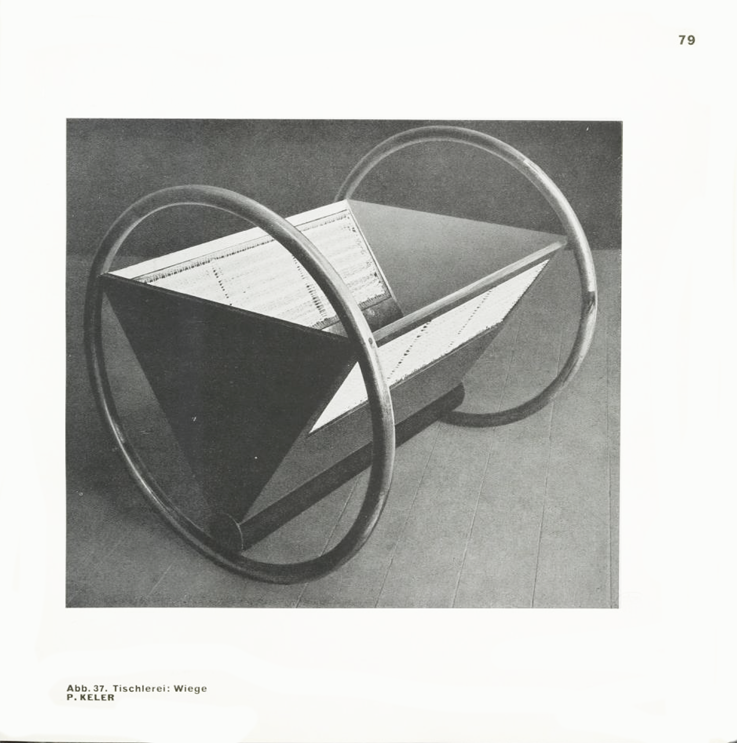
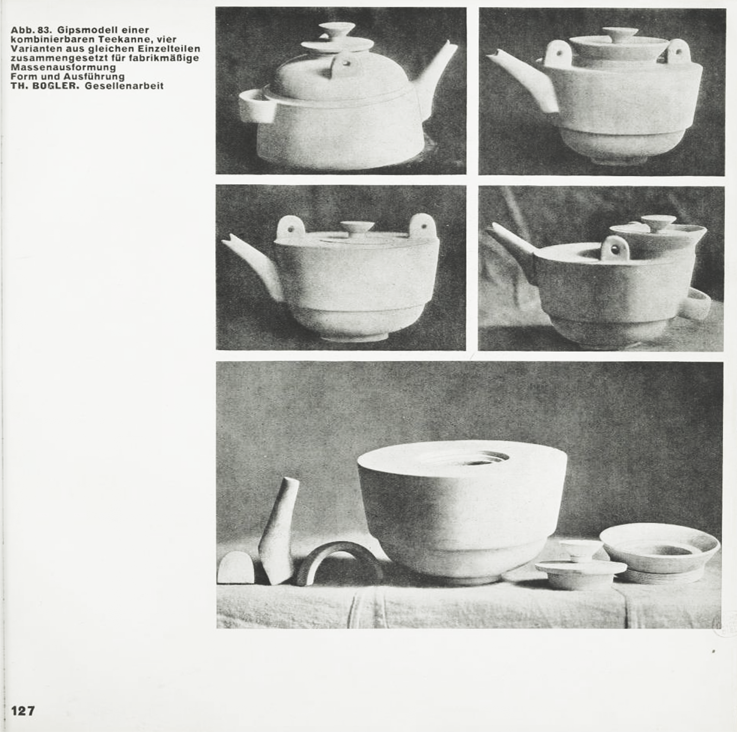
Gypsum model of a combinable teapot, four variants assembled from the same individual parts for industrial mass moulding. Design THEODOR BOGLER. (Journeyman)
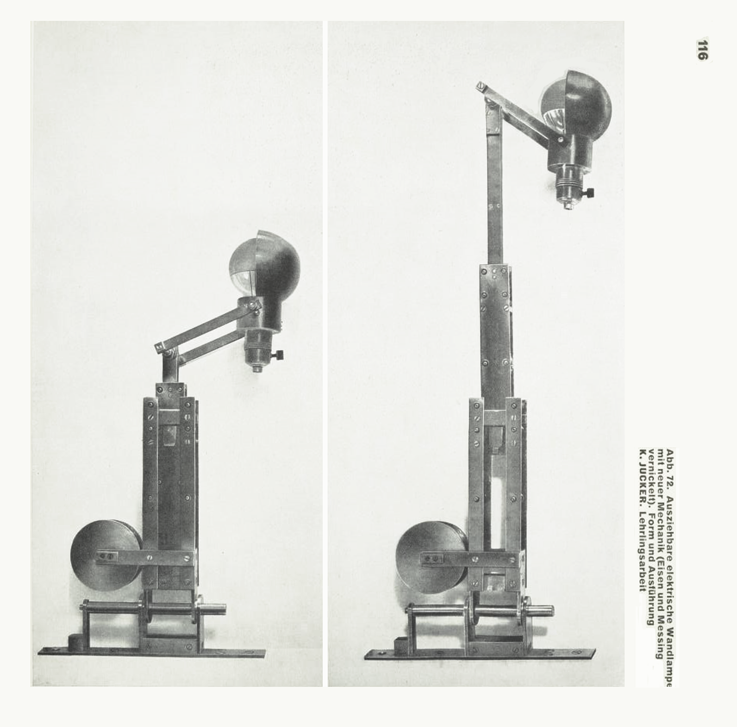
Extendable electric wall lamp with new mechanics (iron and brass nickel plated). Design KARL JUCKER. (Apprentice)
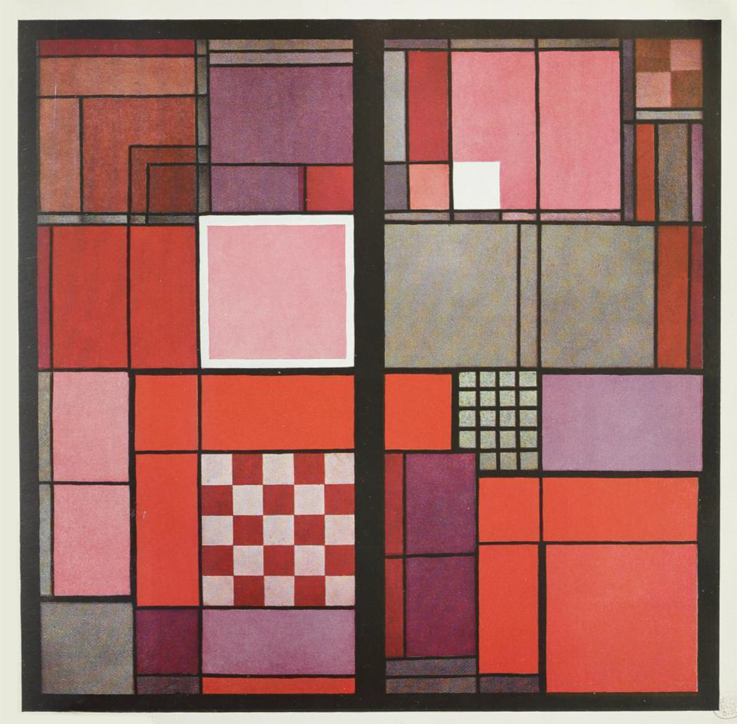
STAINED GLASS
Stained glass window, design JOSEF ALBERS, Journeywork. ©The Josef and Anni Albers Foundation – VG Bild-Kunst, Bonn 2019.
MURAL PAINTING
Doorway
Design PETER KELER and WOLFGANG (FARKAS) MOLNAR
MURAL PAINTING (Storage)
Form master:
Vassily Kandinsky
Crafts master:
Heinz Beberniß
WEAVING
Wall hanging. Design BENITA OTTE (Journeyman)
WEAVING
Form master:
Georg Muche
Crafts master:
Helene Börner
LETTERPRESS
Form master:
Lyonel Feininger
Crafts master:
Karl Zaubitzer
STAGE
Colour chart IX.
Set design for The Mechanical Ballet, KURT SCHMIDT
STAGE
Figurines for The Mechanical Ballet, KURT SCHMIDT, G. TELTSCHER
STAGE
Management Lothar Schreyer
Oskar Schlemmer
(Typography: Lothar Schreyer)
House "The Red Cube" street side. Design WOLFGANG (Farkas) MOLNAR
III. FREE WORK OF MASTERS; JOURNEYMEN AND APPRENTICES
Colour plate XIV. picture with arrow form, 1923. VASSILY KANDINSKY
Colour plate XV. Actor, PAUL KLEE
Colour plate XVII. MARCEL BREUER
Colour plate XIX. FRITZ SCHLEIFER
WOODEN SCULPTURE
Carving of the staircase in the blockhouse Sommerfeld, Berlin. Form and execution JOOST SCHMIDT. (Apprentice)
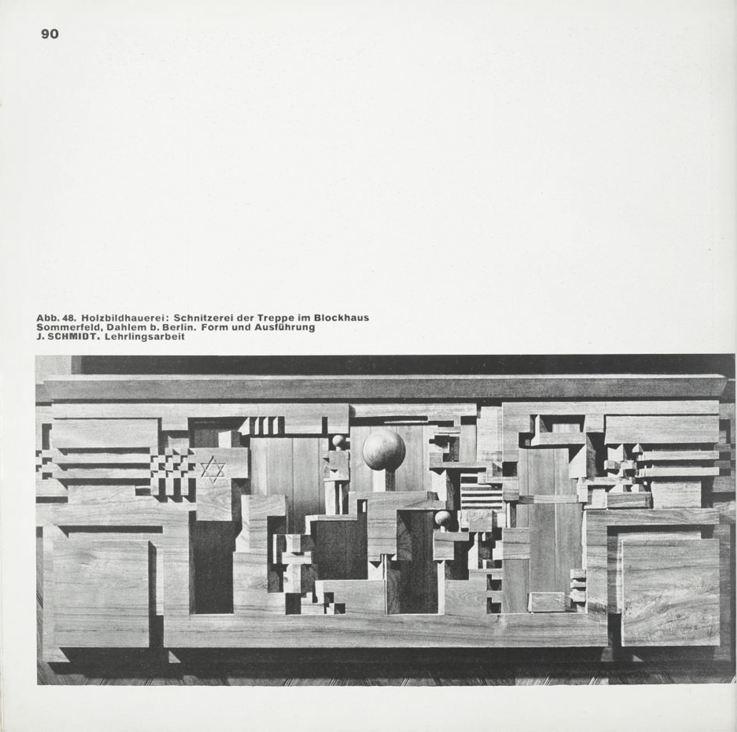
STONE SCULPTURE
Form master:
Oskar Schlemmer
Crafts master:
Josef Hartwig
CARPENTRY
Form master: Walter Gropius
Crafts master: R. Weidensee
WOODEN SCULPTURE
Form master:
Oskar Schlemmer
Crafts master:
Josef Hartwig
I. THE SCHOOL
The apprenticeship is divided into
1. TRAINING IN CRAFTS
Complementary subjects:
a. Instructions in Material and Tools
b. Basics of bookkeeping, calculation, contracts
II. Presentation
1. Projection Theory
2. Study of Construction
3. Working Drawing and Model Making for all Spatial Entities
III. Design
1. Theory of Space
2. Colour Theory
3. Theory of Composition
Complementary subjects:
Lectures from all areas of art and science from the past and present
2. TRAINING IN FORM
I. Contemplation
1. Study of Nature
2. Study of Materials
I. Stone
IV. Clay
III. Metal
II. Wood
V. Glass
VI. Colour
VII. weave
STAINED GLASS
Form master:
Paul Klee
Workshop management:
Josef Albers
I. THE SCHOOL
The apprenticeship is divided into
1. Training in Crafts
I. Stone II. Wood III. Metal IV. Clay V. Glass VI. Color VII. Textiles
The training comprises three sections:
1. The Preliminary Course
Duration: half a year. Elementary instructions of form in connection with material exercises in the special workshop for the preliminary course.
2. Crafts Course
... with the completion of a legal letter of apprenticeship and supplementary form theory. Duration: 3 years. Result: journeyman's certificate of the "Chamber of Crafts", if applicable of the Bauhaus.
3. Building Course
Craft work in construction (on building sites of the practice) and free training in construction (on the tasting ground of the Bauhaus) for specially qualified journeymen. Duration: depending on performance and circumstances. Result: The master craftsman's certificate of the "Chamber of Crafts" and, if applicable, of the Bauhaus.
Complementary subjecs:
a. Instructions in Material and Tools
b. Basics of bookkeeping, calculation, contracts
I. Contemplation
1. Study of Nature
2. Study of Materials
II. Presentation
1. Projection Theory
2. Study of construction
3. Work drawing and model making for all spatial entities
III. Design
1. Theory of Space
2. Color Theory
3. Theory of Composition
2. Training in Form
Complementary subjects:
Lectures from all areas of art and science from the past and present
STUDY OF NATURE
SPATIAL RAUMLEHRE
FARBENLEHRE KONSTRUKTIONSLEHRE KOMPOSITIONSLEHRE
III. FREE WORK OF MASTERS; JOURNEYMEN AND APPRENTICES
BAUHAUS BOOK
STAATLICHES BAUHAUS IN WEIMAR
1919–1923
Albert Langen, 1923
234 pages
STAINED GLASS
Form master: Paul Klee
Workshop management:
Josef Albers
METAL WORKSHOP
Form master:
L. Moholy-Nagy
Crafts master
Christian Dell
POTTERY
Form master: Gerhard Marcks
Crafts master: Max Krehan
Curriculum, Exhibition Catalogue MoMA 1938.
Cover design: Herbert Bayer
The training comprises three sections:
1. The Preliminary Course
Duration: half a year. Elementary instructions of form in connection with material exercises in the special workshop for the preliminary course.
2. Crafts Course
... with the completion of a legal letter of apprenticeship and supplementary form theory. Duration: 3 years. Result: journeyman's certificate of the "Chamber of Crafts", if applicable of the Bauhaus.
3. Building Course
Craft work in construction (on building sites of the practice) and free training in construction (on the tasting ground of the Bauhaus) for specially qualified journeymen. Duration: depending on performance and circumstances. Result: The master craftsman's certificate of the "Chamber of Crafts" and, if applicable, of the Bauhaus.
The Preliminary Course
Applicants for an apprenticeship at the Bauhaus will be selected on the basis of their own submitted works according to their probable work and formal assessment. The selection by the masters is subjective and therefore subject to errors, because there is no anthropometric system that reliably predetermines the ability and possibility of development of a living, changing individual. The very limitation of space and means of work, however, demands the decision to make a choice. [...]
Any binding attitude to any style movement is deliberately avoided. Observation and representation - with the intention of recognizing the ideal identity of form and content limit the scope of the preliminary course.
The most necessary task is the unleashing of individuality, its liberation from the dead convention in favour of personal experiences and insights, which convey to it the awareness of the limits of its creative power set by nature..
That is why collective work is not yet essential for the preliminary course. The subjective observation is cultivated alongside the objective, the exploration of abstract regularity just as much as the interpretation of the representational. Pedagogy itself can be highly stimulating.
The knowledge and correct assessment of the individual means of expression should above all be achieved. The creative possibilities of different individualities are differently limited.
The admission of the apprentices to a workshop of their own choice depends on the quality of their performance in the half year of the preliminary course and on their personal suitability.
Training in handwork and form
The best teaching is the free master teaching as it existed in earlier centuries, which did not know any school-based work and art education. The old masters possessed both craftsmanship and formal ability. [...] We only have the path of synthesis, i.e. the simultaneous influence on the apprentice from two sides, from the manual to the technically outstanding master craftsman, from the formal to the artistic personalities. […]
The Bauhaus has therefore established the principle:
Each apprentice and journeyman learns simultaneously from two masters, a handicraft master and one master of design. Both are closely linked.
The theory of the crafts and the theory of design provide the basis: no apprentice or journeyman can be freed from one or the other.
THE
NEW TYPOGRAPHY
L. Moholy-Nagy
Typography is a tool of communication. It has to be communication in its most intense form. The emphasis must be on absolute clarity since this distinguishes the character of our own writing from that of ancient pictographic forms. Our intellectual relationship to the world is individual-exact (resp. this relationship is nowadays in a state of transition toward a collective-exact orientation) in contrast to the ancient individual-amorphous and later collective-amorphous mode of communication.
So, first of all: unambiguous clarity in all typographical compositions.
Readability - communication must never be impaired by an a priori esthetics. Letters may never be forced into a predetermined framework, e.g. a square. The printing corresponds to the content through its specific optical and psychological laws, demanding their typical design. The essence and purpose of printing demand an uninhibited use of all linear directions (therefore not only horizontal articulation).
We use all typefaces, type sizes, geometric forms, colors, etc. We want to create a new language of typography whose elasticity, variability; and freshness of typographical composition is exclusively dictated by the inner law of expression and the optical effect.
The most important aspect of contemporary typography is the use of zincographic techniques, meaning the mechanical production of photoprints in all sizes. What the Egyptians started in their inexact hieroglyphs whose interpretation rested on tradition and personal imagination, has become the most precise expression through the inclusion of photography into the typographic method. Already today we have books (mostly scientific ones) with precise photographic reproductions; but these photographs are only secondary explanations of the text.
The latest development supersedes this phase, and small or large photos are placed in the text where formerly we used inexact, individually interpreted concepts and expressions. The objectivity of photography liberates the receptive reader from the crutches of the author’s personal idiosyncrasies and forces him into the formation of his own opinion.
It is safe to predict that this increasing documentation through photography will lead in the near future to a replacement of literature by film. The indications of this development are apparent already in the increased use of the telephone which makes letterwriting obsolete. It is no valid objection that the production of films demands too intricate and costly an apparatus. Soon the making of a film will be as simple and available as now printing books.